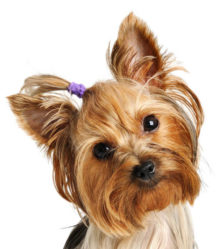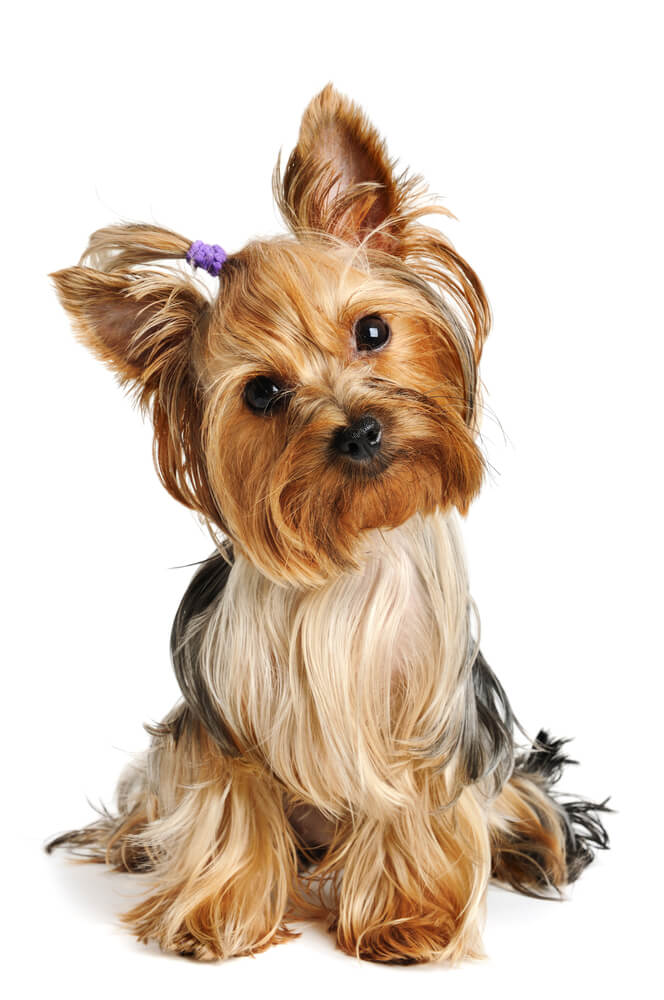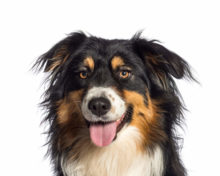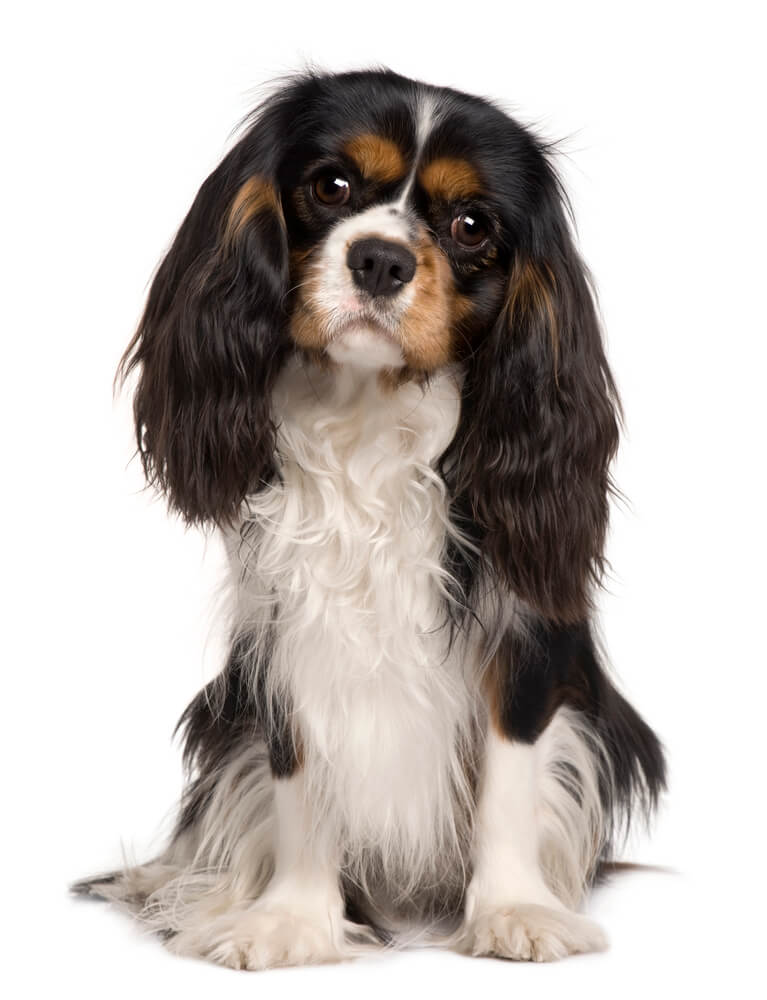Yorkshire Terrier

Yorkshire Terrier breed is originally from United Kingdom. Also known as Yorkie.
Breed information
| Popularity |
|
| Name | Yorkshire Terrier |
| Other names | Yorkie |
| From country | United Kingdom |
| Standards | |
| Breed groups | Toy (AKC),Companion (UKC) |
| Type | Purebred |
| Size | Tiny |
| Life span | 12 - 16 years |
| Temperament | alert,courageous,energetic,independent,intelligent,loyal,playful |
| Height female | 8-9 inches (20-23 cm) |
| Height male | 8-9 inches (20-23 cm) |
| Weight female | 4-6 pounds (1.8-2.7 kg) |
| Weight male | 4-6 pounds (1.8-2.7 kg) |
| Colors | black & gold,black & tan,blue & gold,blue & tan |
| Litter Size | 4 - 6 puppies |
| Puppy Price | Average $800 - $1500 USD |
Yorkshire Terrier breed image

Yorkshire Terrier Pros and Cons
There are 3 pros and 3 cons of owning Yorkshire Terrier.
| Pros 👍 | Cons 👎 |
|---|---|
| Doesn't shed much | Kids unfriendly |
| Normally doesn't have problems with health | Difficult to groom |
| Hypoallergenic | Needs a lot of exercises |
Breed Characteristics
| Sensitivity Level |
Low-sensitive
High-sensitive
|
High-sensitivity dogs can be deeply affected by their owner's actions. If you shout loudly at the dog, ignore it, or if your child pulls its tail, it may take offense. On the other hand, low-sensitivity dogs, often referred to as 'tolerant' dogs, handle these situations more easily. If you're an emotional person, have a busy lifestyle, sometimes neglect your dog, or have young children, we don't recommend getting a high-sensitivity dog. |
|
| Kid-Friendly |
No-Kid-Friendly
Kid-Friendly
|
Kid-friendly dogs are highly tolerant of children's behavior, including hugs and playful "games" like attempting to saddle them. They typically interact kindly and patiently with kids, making them great family pets. Not Kid-Friendly Dogs - Dogs in this category do not tolerate such behavior from children and may react negatively or even aggressively. Be cautious about bringing a not kid-friendly dog into a family environment. |
|
| Dog Friendly |
Low-friendly
High-Friendly
|
Dog-friendly characteristics vary widely, ranging from low-friendly to high-friendly. It's important to note that a dog's level of friendliness depends on several factors, and breed is just one of them. Dogs with high friendliness tend to be sociable and enjoy interacting with other dogs. They may happily play with other canines or simply remain calm and relaxed when in the company of other dogs. Conversely, dogs with lower levels of friendliness may exhibit different behaviors. They might be more prone to barking, trying to engage in fights with other dogs, or even attempting to run away from unfamiliar dogs or situations. Keep in mind that a dog's friendliness is influenced by their individual personality, upbringing, and experiences. So, it's essential to consider these factors when assessing your furry friend's social behavior. |
|
| Friendly Toward Strangers |
Not-friendly
Everyone Is My Best Friend
|
It's important to understand that a dog's behavior towards strangers is influenced by various factors, with breed being just one of them. A dog that is friendly toward strangers will typically exhibit pleasant behavior when your friends or visitors come to your home. They won't display aggression or attempt to attack them. Instead, they will likely be welcoming and sociable. On the other hand, some dogs may be naturally shy or even fearful of strangers. However, it's crucial to note that a dog's socialization plays a significant role in their behavior. Proper socialization lessons can help any dog become more welcoming to strangers, regardless of their breed. That said, if you happen to choose a breed known for its high stranger-friendly rating but don't invest time in training and socialization, the dog may still exhibit unfriendly behavior toward your visitors. Remember, a dog's behavior is a product of both their breed tendencies and their upbringing. |
|
| Amount Of Shedding |
No Shedding
Hair Everywhere
|
|
What's crucial to note is that the extent of shedding can vary from one breed to another. Some dogs shed consistently throughout the year, while others may have specific seasonal shedding patterns. There are also breeds that shed minimally, and in some cases, almost not at all. When choosing a dog, it's essential to consider your personal preferences and standards regarding shedding. Your choice should align with how much you're willing to handle in terms of grooming and cleaning to keep your home and clothes free from excessive dog hair. |
|
| Easy To Groom |
Easy
Hard
|
|
Some breeds are low-maintenance and can be brushed quickly and easily. Others may need regular clipping, grooming, and bathing to keep them looking their best. When choosing a dog, it's important to assess how much time and money you're willing to invest in their grooming needs. Your decision should align with your preferences and your commitment to providing the necessary care for your furry friend. |
|
| General Health |
Need more attention to health
Healthy as an ox
|
|
It's important to be aware that some dogs may face health challenges due to irresponsible breeding practices. One example of such health issues is hip dysplasia, which is a genetic problem. However, it's essential to understand that not every dog of a specific breed will develop these health issues, although they may be more prone to them. When adopting a puppy, it's a good practice to gather information about any genetic illnesses associated with the breed. For more detailed information, you may also want to consult with a shelter or rescue organization, as they can provide insights into the physical health of the puppy's parents or siblings. |
|
| Easy To Train |
Self-Willed
Eager to Please
|
|
It's worth noting that some dog breeds are more trainable than others. For instance, certain breeds may quickly grasp and establish associations between words like 'stay,' corresponding actions (such as staying in place), and the resulting rewards. On the other hand, some breeds may require more time and attention during training. Dogs are highly intelligent animals, but they often like to understand what's in it for them when they follow your commands. This is where games and rewards can be valuable tools in training and motivating them. |
|
| Intelligence |
Low
High
|
|
Different dog breeds excel in specific tasks and exhibit varying levels of intelligence, concentration, and quick decision-making abilities. For instance, breeds bred for their intelligence, like Border Collies, may excel in activities such as herding livestock. These dogs require more mental stimulation to thrive compared to breeds designed for physical endurance and running. Understanding your dog's specific needs is essential to ensure they are mentally engaged and don't engage in unwanted behaviors like chewing and digging. To meet these needs, consider interactive toys and activities, such as obedience training for dogs in need of mental engagement, or search and rescue activities for those with high activity levels and keen senses. |
|
| Tendency To Bark Or Howl |
Only To Alert
Avid singer
|
|
It's important to understand that vocalization varies between dog breeds. Some dogs are naturally more vocal, and they can bark and howl at different pitches. For instance, consider the hound, known for its distinctive barking and howling. You'll need to decide if the sound of their vocalizations might become bothersome or if you find it somewhat musical. Additionally, if your chosen breed has a history of hunting, they might constantly chase and howl at nearby wildlife. If you're looking for a watchdog and your dog is alert, it may bark at everyone it encounters. These factors are essential to consider when selecting a dog breed, especially if you have neighbors or are subject to any noise restrictions. |
|
| Energy Level |
Couch Potato
High Energy
|
|
A dog's energy level is often influenced by their breeding, as some breeds were designed for specific tasks like herding livestock or retrieving game for hunters. Dogs with high energy levels will require plenty of interaction and exercise. They tend to be more active and enjoy activities such as playing, running, tumbling, and exploring new smells and sights. On the other hand, some breeds are low-energy and prefer lounging on the couch with you, taking naps, and enjoying Netflix marathons. When choosing a dog breed, it's essential to consider your own activity level and lifestyle. Select a breed that aligns with your preferences and can comfortably fit into your daily routine. |
|
| Exercise Needs |
Low
Need a lot
|
|
Different dog breeds have varying requirements when it comes to physical activity. Some breeds may be content with a leisurely stroll in the evening, while others might crave several vigorous laps around the block. Their exercise needs are often linked to their original purposes, such as hunting or herding, which influence their energy levels. Dogs with high energy levels that don't receive adequate exercise may be prone to weight gain and may engage in behaviors like digging, chewing, and excessive barking. High-energy dogs tend to thrive when paired with individuals who are active, enjoy the outdoors, or have an interest in training their dog for competitions. |
|
| Potential For Playfulness |
Only When You Want To Play
Non-Stop
|
|
Dog breeds exhibit a wide range of personalities, and this includes their inclination for play. Some breeds are consistently playful and seem to stay in a perpetual puppy state of mind. In contrast, other breeds tend to be more serious and enjoy their moments of relaxation. When choosing a dog, it's important to consider whether the idea of having a playful companion excites you or if you prefer a more relaxed and laid-back dog. Additionally, factors such as the presence of children or other pets in your household should be taken into account. Another option to explore is adopting an older dog, which might be less demanding but still enjoys interacting and playing, providing a balance between playfulness and a calmer demeanor. |
|
Introduction
Yorkshire terriers are one of the most popular dogs in the world. It is one of the smallest breeds of dogs with a very cheerful and sociable temperament. They differ from other breed by its loyal, brave and self-confident character. Therefore, they are suitable for the maintenance of both experienced and inexperienced owners. Yorkshire terriers are very intelligent dogs, but sometimes it became not so easy to teach them as they have very independent character. Despite its small size, courageous and independent Yorkshire, often try to dominate other dogs, as though ignoring their status. This breed of dog can have children who will be very gentle to handle this dog already understands that this fragile animal can easily cause injury. What is interesting, this breed is almost does not fade and can be therefore suitable to people who are allergic to pets.Some Facts
- Country of origin: England.
- Height: 21 - 23 cm.
- Weight: 2 - 3 kg.
- The content of the apartment: well suited.
- Lifespan: 12 - 15 years.
- Good for: inexperienced owners.
Historical Background
Homeland of Yorkshire terrier is Yorkshire and Lancashire in northern England. This breed was popular in the XVIII-XIX centuries in Yorkshire and was described as "a small, blue-gray dog with a semi-long hair." These dogs were kept as the peasants, as they were forbidden to bring large dogs, so they do not poach on the lands belonging to the nobility. Small dog guarded the house from rodents and accompanied their masters in shopping trips along the rivers and canals. Some experts call among the ancestors of Yorkies and Maltese lapdogs, although they are very different from them: in Maltese hanging ears and white color. It is believed that Yorkshire crossed with lapdog, to improve the quality of the wool, the structure of hair and get silky. In favor of this theory says that in light Yorkies are often very good quality wool. New breed do weavers, working on new factories. They managed to bring a dog with long silky hair bluish-steel color with pure golden-brown tan. Yorkie that time had a longer body and larger in size than the modern, common to them was a mass of 6-7 kg. A new breed called "blue-and-tan Yorkshire Terrier” quickly gained popularity, displacing other species of small English terrier. In 1886, the breed was recognized by the Kennel Club and entered in the studbook. In 1898, the first club of the Yorkshire Terrier has been organized.Diseases of the Yorkshire Terrier
Most often, Yorkshire Terriers are observed to the following diseases:- patella luxation;
- liver disease;
- inflammation of the pancreas;
- low blood sugar;
- allergy;
- problems with teeth and gums;
- sensitivity to drugs.
How to Care after Yorkshire Terrier
The distinguishing feature of Yorkshire terriers is that they do not shed, unlike most other breeds of dogs. However, Yorkies are not that kinds of dogs which easy to clean. Despite the fact that at the beginning of its life Puppies do not need a lot of care, it is best to start to teach York to the small procedures withdrawal from puppyhood. It usually takes about 6 months to have a puppy York grew long hair. You should take care after your dog, especially if you want to get silky coat. It may take a lot of time to care for this breed. If Yorkie does not participate in trade shows, it can be cut. In order to coat Yorkshire terrier looked well-groomed it is necessary to comb almost daily. You may also want to use a special oil for grooming. Oil protects the hair and prevents tangling.Video about Yorkshire Terrier breed
Questions and answers about Yorkshire Terrier
if you have no experience in dog training and you aren't going to train a dog with an expert, then no. Yes, in case Yorkshire Terrier is properly raised, trained, and well-socialized. It can be great with children if raised with them early on.
The average life expectancy of a Yorkshire Terrier is between 12 - 16 years.
If your Yorkshire Terrier is pregnant, it is safe to assume that litter can have anywhere from 4 to 6 puppies.
If you purchase Yorkshire Terrier from a breeder it can be much more expensive than a shelter. A purebred Yorkshire Terrier costs between US$ 800 and US$ 1500 from a reputable breeder, but there are several advantages to doing so. First, a breeder will usually allow you to meet the parents to get a good idea about what the puppy will look like and behave. You will also see if the parents have any health problems. Breeders will also supply you with paperwork that documents your pet’s lineage.
Yes, we can say that Yorkshire Terrier is popular in America. They are in top 20 the most popular purebred dog in USA. Yorkshire Terrier have got #13 rank in 2020, #13 in 2021 and #13 in 2022 by American Kennel Club (AKC).
Yes, Yorkshire Terrier dogs are considered hypoallergenic. They have hair instead of fur, which means they do not shed as much as other breeds and produce less dander, the primary cause of pet allergies. However, it's worth noting that no dog breed is completely hypoallergenic, and people with severe allergies may still react to Yorkshire Terrier. If you are allergic to dogs, it's always a good idea to spend time with a Yorkshire Terrier before bringing one home to see if you have any allergic reactions.
- https://www.akc.org
- FCI standard
- Kennel club standard
- Wikipedia https://en.wikipedia.org/wiki/Yorkshire_Terrier
Next and previous breeds by Popularity

Australian Shepherd
Popularity: №12

Cavalier King Charles Spaniel
Popularity: №14